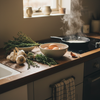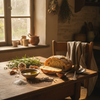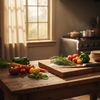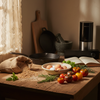What Is Spatula? 7 Types Every Home Chef Needs
What Is a Spatula? Your Essential Kitchen Companion
Ever stood in your kitchen, staring at a recipe that calls for a "spatula," and wondered which of the five different flat tools in your drawer it actually means? You're not alone. The humble spatula might be one of the most essential—and most misunderstood—tools in any kitchen.
Key Takeaways
- A spatula is a flat-bladed kitchen tool used for mixing, spreading, scraping, and lifting food.
- There are seven main types of spatulas every home chef should have, each serving a specific purpose.
- Turner spatulas are ideal for flipping, while scraper spatulas are best for mixing ingredients.
- Offset spatulas are perfect for spreading, and fish spatulas handle delicate foods with care.
- Other types include spoon spatulas for stirring, grill spatulas for outdoor cooking, and palette knife spatulas for decorating.
Table of Contents
Here's the thing: what is spatula isn't just one simple answer. This versatile tool has evolved far beyond its ancient origins, branching into specialized forms that can make or break your culinary adventures. Whether you're flipping pancakes without tearing them, folding delicate meringue, or spreading frosting like a pro, the right spatula transforms frustrating kitchen moments into confident victories.
From the professional kitchens where chefs demand precision to home kitchens where families create memories, spatulas have earned their place as indispensable tools. But with so many types available—from heat-resistant silicone scrapers to precision offset spatulas—knowing which one to reach for can feel overwhelming.
Did You Know? The word "spatula" comes from the Latin "spatha," meaning "broad blade." Originally used in ancient Rome for mixing medicines and spreading ointments, spatulas have been helping humans create and craft for over 2,000 years.
Today's spatulas serve far beyond the kitchen. Spatula uses in laboratory settings include transferring chemicals and scraping samples, while medical spatulas help with examinations and sample collection. But for home chefs like you, understanding the seven essential types can revolutionize how you cook, bake, and create.
Whether you're tackling your first soufflé or perfecting your signature dish, the right spatula becomes an extension of your hands—protecting your cookware, preserving your food's integrity, and giving you the confidence to attempt that daunting recipe you've been eyeing. Because at DI ORO, we believe the right tools don't just make cooking easier; they make it joyful.
Ready to discover which spatulas deserve a spot in your kitchen arsenal? Let's dive into the seven types that will transform you from spatula-confused to spatula-confident, ensuring you never again wonder what is spatula used for in any recipe.
The 7 Essential Spatula Types Every Home Chef Needs

Understanding the different types of spatulas transforms kitchen confusion into culinary confidence. Each spatula serves specific purposes, and knowing which one to reach for can mean the difference between a perfectly flipped pancake and a torn mess. Let's break down the seven essential types that belong in every serious home chef's arsenal.
1. Silicone Scraper Spatula - The Baking Champion
The silicone scraper spatula reigns supreme in the baking world. With its flexible blade and heat-resistant properties, this spatula excels at folding delicate batters, scraping every last bit of mixture from bowls, and stirring hot ingredients without melting or warping.
- Heat resistant up to 600°F (like our award-winning DI ORO spatulas)
- Flexible blade reaches every corner of mixing bowls
- Non-stick cookware safe
- Easy to clean and dishwasher safe
- Won't absorb odors or stains
Best for: Folding meringues, scraping cake batters, stirring sauces, and any task requiring gentle handling of ingredients.
2. Turner/Flipper Spatula - The Breakfast Hero
When Americans say "spatula," they often mean the turner—that flat, broad blade perfect for flipping pancakes, burgers, and eggs. This spatula features a thin, sturdy blade that slides easily under foods without breaking them apart.
Still wondering whether your flat tool is technically a spatula or a turner? Check out our dedicated blog on Spatula vs Turner to clear up the confusion and learn when to use each tool for better results in your kitchen.
Pros
- Excellent for flipping and lifting flat foods
- Thin blade slides under delicate items easily
- Available in various sizes for different foods
- Heat-resistant options available
Cons
- Metal versions can scratch non-stick surfaces
- Limited flexibility for scraping tasks
- Not ideal for mixing or folding
3. Offset Spatula - The Decorator's Dream
The offset spatula features a blade that's angled downward from the handle, creating clearance between your hand and the work surface. This design makes it invaluable for frosting cakes, spreading batters, and creating smooth, professional finishes.
What is spatula used for in professional baking? The offset spatula answers that question perfectly—it's the secret weapon pastry chefs use to achieve those Instagram-worthy cake decorations and perfectly smooth frosting layers.
4. Fish Spatula - The Delicate Food Specialist
Don't let the name fool you—fish spatulas excel with any delicate food. Their thin, flexible blade and slotted design allow excess oil to drain while providing the precision needed to handle fragile items like fish fillets, crepes, or delicate cookies.
5. Grill Spatula - The Outdoor Cooking Champion
Built for the heat and demands of outdoor cooking, grill spatulas feature extra-long handles, oversized blades, and heavy-duty construction. They're designed to handle large portions and withstand high temperatures while keeping your hands safely away from the heat.
6. Mini Spatula - The Precision Tool
Sometimes called a spoonula, the mini spatula combines the best features of a spoon and spatula in a compact design. Perfect for small jars, getting into tight spaces, and handling small quantities of ingredients with precision.
7. Laboratory Spatula - The Scientific Specialist
While not typically found in home kitchens, understanding spatula uses in laboratory settings helps appreciate the tool's versatility. Laboratory spatulas, made from stainless steel or disposable plastic, transfer powders, scrape samples, and handle chemicals with contamination-free precision.
Pro Tip: Invest in spatulas made from pro-grade, forever-chemical-free silicone. They'll last longer, perform better, and keep your food safe from harmful chemicals that can leach from lower-quality materials.
Each spatula type serves distinct purposes, but the magic happens when you understand which tool matches your task. A silicone scraper spatula might be perfect for folding chocolate chips into cookie dough, while an offset spatula transforms your cake decorating from amateur to professional-looking in minutes.
The key to spatula success lies in building a collection that covers your cooking style. Whether you're a weekend baker, grilling enthusiast, or everyday cook, having the right spatula for each task eliminates frustration and elevates your results.
Choosing the Right Spatula for Your Needs
Selecting the perfect spatula isn't just about grabbing the first one you see—it's about matching the tool to your cooking style, cookware, and most common kitchen tasks. The right spatula becomes an extension of your hand, making every flip, fold, and scrape feel effortless.
Silicone Spatulas
- Safe for all cookware types, including non-stick
- Heat resistant up to 600°F
- Flexible for thorough bowl scraping
- Easy to clean and dishwasher safe
- Won't absorb odors or stains
Metal Spatulas
- Can scratch non-stick surfaces
- May conduct heat from hot pans
- Less flexible for mixing tasks
- Harder to clean thoroughly
Cookware Compatibility Guide
Your cookware dictates which spatula materials you can safely use. Non-stick surfaces require gentle silicone or plastic spatulas, while stainless steel and cast iron can handle metal tools. Understanding this relationship prevents costly cookware damage and ensures your spatulas last longer.
For ceramic and enameled cookware, stick with silicone options to prevent chipping. Carbon steel pans, like cast iron, can accommodate metal spatulas but benefit from silicone for delicate tasks like scrambled eggs.
Professional vs. Home Kitchen Considerations
Professional kitchens demand durability and speed, often favoring stainless steel spatulas that withstand constant use and high-temperature dishwashing. Home cooks, however, benefit more from versatile silicone options that protect their cookware investment while handling diverse cooking tasks.
The key difference lies in frequency of use and replacement cycles. Professional tools prioritize performance over longevity, while home kitchen spatulas should balance performance with durability and safety.
Spatula Care and Maintenance

Proper spatula maintenance extends their lifespan and ensures food safety. Different materials require specific care approaches, but all spatulas benefit from immediate cleaning after use and proper storage.
Cleaning Best Practices
Silicone spatulas clean easily with warm soapy water or in the dishwasher. For stubborn odors, soak in baking soda solution overnight. Metal spatulas require thorough drying to prevent rust, while wooden spatulas need periodic oiling to prevent cracking.
Never use abrasive cleaners on any spatula material, as they can create microscopic scratches that harbor bacteria. For laboratory-grade cleanliness, sanitize spatulas with food-safe sanitizing solutions, especially important when handling raw proteins.
Storage and Organization
Store spatulas in utensil crocks or magnetic strips to prevent blade damage. Avoid cramming multiple spatulas together, which can cause silicone to tear or metal to scratch. Drawer storage works well with dividers that keep each spatula separated.
Advanced Spatula Techniques
Mastering advanced spatula techniques transforms ordinary cooking into culinary artistry. These professional methods work with any quality spatula but shine with precision tools designed for specific tasks.
The Perfect Flip Technique
The secret to perfect flips lies in confidence and timing. Slide the spatula completely under the food, lift decisively, and flip with a quick wrist motion. Practice with sturdy foods like pancakes before attempting delicate items like fish fillets.
For extra-large items, use two spatulas working in tandem—one to lift, one to guide. This technique prevents breaking and ensures even cooking on both sides.
Professional Folding Methods
Proper folding preserves air bubbles in batters and prevents overmixing. Use the spatula's edge to cut through the mixture, then fold from bottom to top with gentle, sweeping motions. Rotate the bowl as you work to ensure even incorporation.
Pro Technique: When folding delicate ingredients like whipped cream into batter, add one-third first to lighten the mixture, then fold in the remainder. This prevents deflation and maintains texture.
The Spatula Revolution in Your Kitchen

Understanding what is spatula and its various types transforms your cooking from guesswork to precision. Each spatula serves specific purposes, from the versatile silicone scraper that conquers baking challenges to the specialized offset spatula that elevates cake decorating to professional levels.
The evolution from basic flipping tools to specialized instruments reflects cooking's growing sophistication. Whether you're exploring spatula uses in laboratory settings or perfecting your pancake technique, the right spatula makes the difference between frustration and culinary success.
Invest in quality spatulas made from pro-grade materials—they'll reward you with years of reliable service and safer cooking. Your spatula collection should grow with your skills, adding specialized tools as you tackle new culinary challenges.
Remember, the best spatula is the one that feels natural in your hand and matches your cooking style. Start with versatile silicone options, then expand based on your most frequent cooking tasks. With the right spatulas in your arsenal, every flip, fold, and scrape becomes an opportunity to cook with confidence and creativity.
SHOP BEST SLLERS
Frequently Asked Questions
What is the use of spatula?
A spatula is a versatile kitchen tool used to flip, spread, scrape, and mix ingredients during cooking and baking. It helps effortlessly maneuver food items in pans, bowls, and on baking sheets, making tasks like flipping pancakes, folding batter, or scraping every last bit of batter from a bowl smoother and more efficient.
What is the definition of a spatula?
A spatula is a flat, broad kitchen utensil typically made from silicone, metal, or plastic, designed for lifting, flipping, spreading, or scraping food during preparation and cooking. Its flexible, heat-resistant surface allows it to work seamlessly with various cookware without damaging non-stick coatings.
What is a spatula in medical terms?
In medical terms, a spatula refers to a flat, blunt instrument used by healthcare professionals to manipulate tissues, apply ointments, or collect samples. It is commonly used for tasks like throat examinations or applying medication to specific areas.
What is a spatula in chemistry?
In chemistry, a spatula is a small, flat tool used for scooping, transferring, or applying small amounts of powders and chemicals. It allows precise handling of substances in laboratory settings without contamination or spillage.
What is another name for a spatula?
Another name for a spatula can vary by use, including terms like scraper, turner, or spoonula in the kitchen context, and in some cases, a palette knife or lab scoop in professional settings. These names emphasize specific functions such as scraping, flipping, or scooping.
Why are spatulas good?
Spatulas are good because they combine flexibility, heat resistance, and durability to make cooking easier and more enjoyable. High-quality spatulas, especially those made with pro-grade, chemical-free silicone, protect your cookware, maintain food safety, and withstand high temperatures, turning kitchen challenges into smooth, confident cooking moments.




